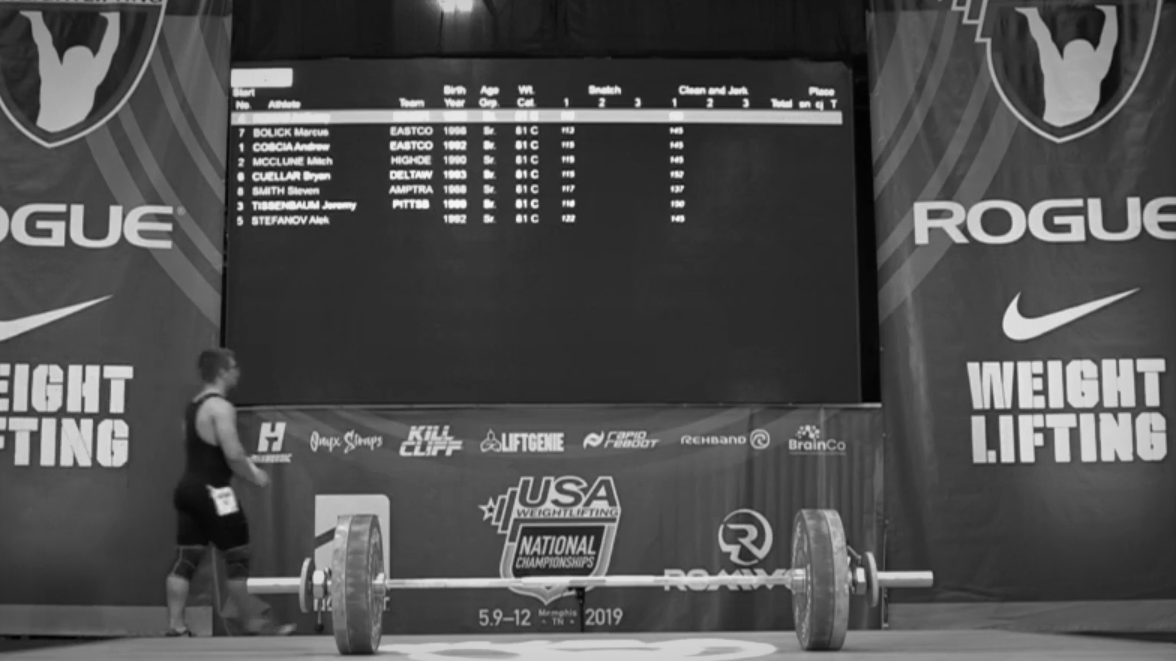6 Takeaways from the World Weightlifting Championships
Strength & ConditioningABOUT THE AUTHOR

Sean Waxman
Sean is the head coach and owner of Waxman’s Gym. He’s been a professional coach for nearly 25 years, a national-level competitive weightlifter, and a graduate-level student of kinesiology and biomechanics. Since opening Waxman’s Gym in 2010, Sean has developed two top-ten finishers at the World Championships, a World University Championship Silver medalist, a Pan Am Championship Silver medalist, and two Pan Am Championship team members. In addition, Sean has developed more than two dozen national-level weightlifters with three National Champions and seven national medalists. Moreover, Sean’s lifters have produced four American records, nine international medals, and nearly two-dozen national medals. Sean has also worked with CrossFitters of all levels including Regionals and Games athletes. When not developing competitive weightlifters and CrossFitters, Sean works with athletes of all skill levels from a wide range of sports to help them develop great skill, strength and power. Sean also has a great passion for helping other coaches learn to teach/coach weightlifting. Sean is currently a Director on the Board of USA Weightlifting, a USA Weightlifting Lead Instructor for Coaching Education, and the former President of the Southern California chapter of USA Weightlifting.
// 6 Takeaways from the World Weightlifting Championships
It doesn’t matter what you or your athletes have accomplished or how many years you’ve been in the business. You should never stop seeking, learning, and trying to improve. I recently went to the World Weightlifting Championships in Indonesia. You can bet the whole time I looked to learn from the globe-spanning coaches, teams, and lifters represented there. Some of these were practical things that I can apply back at Waxman’s Gym. While others are more philosophical. Anyway, here goes with my list of top takeaways from the World Weightlifting Championships.

Your Title Goes Here
Your content goes here. Edit or remove this text inline or in the module Content settings. You can also style every aspect of this content in the module Design settings and even apply custom CSS to this text in the module Advanced settings.
1. Don’t Waste Time on Long, Elaborate Warmups
Over the past few years, terms like “muscle activation” and “dynamic warmup” have become popular. From what I saw. The World Championships elite lifters do not perform these elaborate, hour-long sequences with all kinds of fancy exercises. They jog around a little. Do some bodyweight movements. And mirror what they’ll be required to do on the platform with an empty bar. Maybe they’ll add in a few light sets. But that’s it.
Admittedly, these are some of the most physiologically gifted people on the planet. But the point still holds. Yes, you can prime yourself for peak performance with a dynamic warm up. For most athletes, a long, complicated session is just poor use of time and energy.
This is related to how coaches approach mobility. It’s a part of the puzzle for sure, but only one component. I’ve never been a big fan of athletes working on every single muscle if they have a limitation. I’d rather spend a month on a movement like the overhead squat and see what mobility improvements someone can get. When this holistic approach no longer yields dividends, then perhaps we spend some extra time on the shoulders or ankles. This is ultimately just being capable of getting into an optimal position, maintaining it under load, and finishing well. If they can do this. There’s no need to spend hours going muscle by muscle, as you already have what you need to be successful.
2. There are Many Reasons China is Dominant
At the main training hall I found a high vantage point. It gave me a bird’s eye view of what was unfolding below. The less sophisticated teams were running around like their hair was on fire. Their athletes didn’t seem to have any structure behind what they were doing, and the coaches weren’t providing much direction. Some of the countries who used to get away with having systemic doping programs were more organized. But when it came to competition, it’s evident they haven’t figured out how to replicate the effects of PEDs. Without actually doping.
The Chinese team was clearly a cut above the rest in their preparation. This bore the fruit of them winning more medals than every other team combined. One of the factors in Communist countries is how totally dedicated the lifters are from a very young age. They live, eat, and breathe snatches and clean and jerks, and rarely see their parents. But the sport is a much bigger deal in China. If they’re successful, they and their families will be taken care of for life. Regarding the choice aspect or lack thereof. A friend of mine used to be a world-class competitor for one of the old Soviet bloc nations. In our conversations, it became clear that he doesn’t even like the sport very much. I kind of lost my patience and said, “Well why did you even get into the sport then?”
I felt foolish when he replied, “I could’ve either become a coal miner or a lifter. I didn’t want to die young, so I chose lifting.” In the privileged West, we can’t really understand such limited life choices. Of course, doing a sport was always going to be easier than going down a mine every day. When you remove volition from the equation or the other choice is just plain bad. Like coal mining. Then you see a different kind of all-or-nothing dedication.
Team China certainly displayed this, but there were other things about them that were impressive too. For starters, the technique of every single athlete was virtually flawless. It’s evident how much time they spend on the technical aspect. They also had a whole sports science group that was measuring biometrics. And everything they did in the training hall was purposeful and organized to a tee.
3. When the Lights Go Out, the Show Goes On
At one point, the lights went out in the competition hall. I expected people to start freaking out, and was amazed when this didn’t happen. In fact, the best lifters just continued their preparation in the warmup area like nothing had happened. It didn’t even register in the posture, facial expressions, or preparations that anything had changed. They knew what had to be done, so they went out and did it.
The same was true when these athletes got to the platform. A couple of spotlights stayed on here and both the lifters and their coaches calmly did exactly what they needed to do. Even though they were in semi-darkness. I could see some tension on the faces of the competitors who weren’t contenders, however. This is one difference between the medalist and the also-rans. The ability to take unexpected adversity in stride and just keep going, versus panicking when something goes awry. In competition as in life, there are always variables you cannot control. But you can control how you react to them. The top tier of athletes and their coaches acquitted themselves admirably in this situation.
4. Eat What’s In Front of You
There’s all this hype around Keto and Paleo diets. While I see some validity in these approaches, you don’t see elimination diets very often among the world’s best weightlifters. Of course you can’t just eat like crap all the time. But as long as you’re getting enough calories and protein and eat clean more often than not.
This was demonstrated in the dining hall at the World Championships. A couple of teams had special snacks and ready-made meals flown in. For the most part, the athletes just ate what was put in front of them. The same goes for the coaches. Nobody was counting calories or complaining that their food wasn’t this or didn’t have that.
5. Keep Lifting Heavy to Maintain Strength
For a long time, tapering for weeks before competition was the fashionable thing to do in weightlifting circles. I get the reasoning. You don’t want your athletes to be ground into powder by the time they hit the platform. You do want to allow supercompensation from your final training block to occur. Yet what I observed at the World Championships is that the best teams aren’t doing these long tapers anymore. In fact, their competitors are going fast and heavy. Even in the couple of days before they have to show their stuff. I’ve been tinkering with backing off on tapering with my own athletes for a while.
Nothing dramatic per se, but small, incremental cutting of the tapering time over the past few training years. It used to be that you’d start pulling back four to five weeks before meets. But in those days, there were far less competitions. And so you’d have a greater opportunity to keep fitness and strength up as there were more training days. Now that isn’t the case. In addition to the Olympics and the World Championships, we have the Pan-Am Games. As well as numerous other contests that elite lifters enter.
6. Closer to the Olympics, You See the Difference
The previous World Championships weren’t very long ago, but there was a noticeable and significant difference in the performances. I’m not simply talking about totals, although some people put up some big, impressive numbers. It also showed the focus of the athletes before they took the platform. How clinical their technique was, and how hard they hit it when it counted.
A big reason for this is that Indonesia was the final major tune-up for the 2020 Tokyo Olympics. In the latter stage of the Olympic quadrennial cycle, it’s not fun and games anymore – it’s go time. While there is still a long time before the Games kick off in conceptual terms. In reality it’s just around the corner. This means the best teams are getting their stuff together in every way. They’re all business because unless you have a consistent, centralized approach and an almost unlimited talent pipeline, like China. You never know if the talent you have now will still be available for the next four-year cycle. So you have to make the most of it. So that when the Games come around, your lifters are as ready as they’ll ever be to fulfill their potential.
Want more training content?
More coaches and athletes than ever are reading the TrainHeroic blog, and it’s our mission to support them with useful training & coaching content. If you found this article useful, please take a moment to share it on social media, engage with the author, and link to this article on your own blog or any forums you post on.
Be Your Best,
TrainHeroic Content Team
HEROIC SOCIAL
HEROIC SOCIAL
TRAINING LAB
Access the latest articles, reviews, and case studies from the top strength and conditioning minds in the TH Training Lab

